Trek Speed Concept 7.5 (2011)
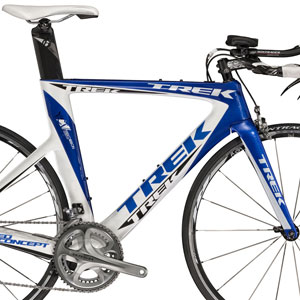
So you want a Speed Concept? So say 44 percent of you, if you are one of those indicating you'll be buying a so-called "superbike" during the 2011 season.
Why has Trek done so well in the superbike poll? One reason is that Trek masterfully rolled out its Speed Concept launch. Another is that a complete bike "Speed Concept" can be bought from $9000 all the way down to $2000, and the carbon version down to $2500.
Another reason is, well, Trek did a nice job with the bike.
The model featured here is in the middle of that price run. Well, a little toward the lower end, but, at $3670 it's right in that sweet spot where you get a lot of bike for a fairly reasonable price. A lot of companies are fighting it out tooth and nail in this circa-$3500 price region, Trek among them.
Back to our poll. When we ask why it is you're buying a Speed Concept, 22 percent said it was because of "integrated brakes." The same percentage said it was the Speed Box that convinced you. 17 percent said "hidden cables." Another 6 percent said "Bayonet style forks," 4 percent said "Duo Trap sensor," and so forth.
Frame
When we asked whether "Kamm-tail airfoils" is the reason for your interest in a Speed Concept, 19 percent of you checked this box. Bingo. At least, if it's the Speed Concept 7.5 your interested in. This, because none of the other features come stock, or at all, on the 7.5 (though you can add some of these features back as accessories, we'll get to that).
What's different about this bike is the Speed Concept's frame aerodynamics and, in particular, its reliance on Kamm tail shapes. That's the case Trek makes in its Speed Concept white paper. I'll not go into the details of the Kamm tail concept, I'll simply refer you to the white paper for that.
Still, here's what you need to consider, if the aerodynamics are what are driving you to the 7.5. It's very likely that much about what makes this bike fast are the first, and the last, things the wind sees. The first thing the wind will see when it hits a Speed Concept 9.5 is a fork, a stem, and a set of front brake calipers you won't get on the 7.5. The last thing you see on a 9.5 is the trailing edge that the Speed Box grants this frame. The last thing you'll see on the 7.5 is not the Kamm Tail, rather whatever it is you put behind the saddle to carry your spare stuff, unless, of course, you invest in the Speed Box (highly recommended).
It's best you understand, when you read Trek's white paper, that some of the features on which the white paper rests its case for its superior aerodynamics are found in the 9 series, not all these features are found in the 7 series.
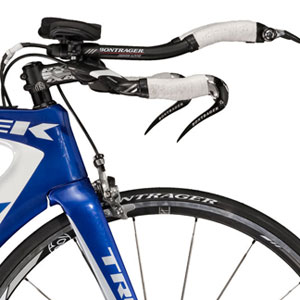
Front end config
This does not mean that the 7.5 is necessarily inferior to the 9.5. You'll spend an extra $2100 to upgrade to the 9.5 and, remember, some people are going to end up not using the original equipment Bontrager Speed Concept aerobar. So, they're going to have to place a "spud" on the 9.5's steerer and stick a standard stem on the bike, so they can use the aerobar of their choice. This, then, reduces the value of the 9.5, both aerodynamically, and, in terms of what you get for what you pay.
The bottom line: Most of the value you get when upgrading to the 9.5 is in the fork and what attaches to it. But the fork requires the use of the Bontrager bar. Before anyone should get too hepped up over the 9.5, he should find out for certain whether the Bontrager bar is going to work for him. After all, it is a contact point, and this ups the ante—this, and the saddle, are the most important elements of your bike. Make sure this bar is what you want. If it isn't, it would be silly to spend the money for a 9.5, when a 7.5 carries most of the same parts, and the same frame, for $2000 less.
Geometry
The Equinox TTX was a bit of a geometric chameleon. Depending on the frame size, the geometric personality of the bike changed. Not so with the Speed Concept. It's graded straight and true—each size strikes the same geometric pose as the next.
As you can see from the data accompanying the graph below, which I've plagiarized from Trek after they plagiarized it from me (with permission), Trek's Speed Concept is designed purposefully to be two things: a tri bike rather than a TT bike; and politically ambivalent. The Speed Concept is neither conservative nor liberal. It is a moderate. In fact, in honor of the 7.5's color, you might call it a geometric Blue Dog.
Because it plays it right down the geometric middle, you have some wiggle room as a user. If you need a taller/narrower bike, or a lower/longer bike, you can do this via a combo of headset spacers, stem pitch, and aerobar geometry. But I'll say what I always say: get as much Speed Concept underneath you as you can. Buy the shorter, flatter stem, and the bigger frame size.
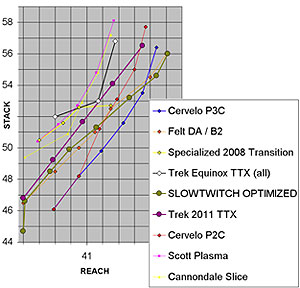
The Bontrager bar spec'd on this bike is of a taller style than the Bontrager that'll go on the higher end Speed Concepts. Still, I wouldn't demand a change to a lower-profile aerobar until I got myself fitted, and saw whether this bar was a good match for me. First things first: Get rid of all but 25mm or less (15mm is close to ideal) of total distance (headset top cap plus spacers) between the head tube top and the bottom of the stem, and, get yourself a flat (-17°) stem on your prospective bike. Make that stem be 100mm if you're riding a 58cm or 60cm bike) or 70mm (if you're riding a 52cm bike or smaller) or something in between in the other sizes. Then decide whether that Bontrager aerobar geometrically works for you.
Just remember, aerobars are like the wheels and tires, and the radio, on a new car you buy. All that stuff is changeable. Make sure that your new Speed Concept 7.5 is how you want it to be spec'd and built when you roll if off the showroom floor—Lord knows these superbikes don't cost you that much less than a car these days; you should be as certain as you can of its final config when you take it away from the shop.
Before I leave the topic of geometry, Trek did something that warms my cockles. It built a small Speed Concept with 650c wheels. Great guys, these Trek engineers. Now those under 5'6" can ride a Speed Concept that fits and handles.
Modularity
This is what makes the 7.5 a really elegant option: you have the ability to get much of the "good" of a Speed Concept without getting boxed into a specific aerobar that may, or may not, be to your liking. Not that there's anything wrong with the Bontrager aerobar. Just, aerobars and saddles are very personal, and the 7.5 is the last bike in the Speed Concept series that gives you the ability to swap bars out without some sort of monetary or aerodynamic penalty being paid if you want to change (i.e., I can think of few good uses for an original equipment Bontrager Speed Concept aerobar if it gets pulled off a Speed Concept in favor of a replacement bar—so you're not going to get much trade-in value for it).
The flip side is also true: if, both geometrically and comfort-wise, Bontrager's Speed Concept aerobars appeal to you—that's a slightly different bar, remember, than what comes on the 7.5–you might think of girding your loins and up-spending to the 9.5. This, because it's hard to find your ideal aerobar, and if you find it aboard the Speed Concept 9.5, here's a bona fide reason to spend the extra money and reach up to the 9.5.
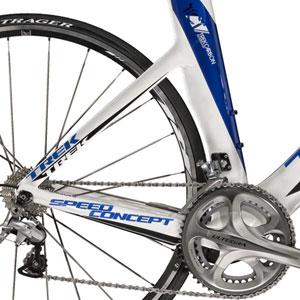
Handling
Trek does something opposite of Cervelo. And it's striking. While Cervelo raises its bottom bracket versus the industry standard, Trek drops its bottom bracket. What this means, on paper, is that Treks are going to handle slightly better around corners, on descents, and the like. But you can pedal around corners on your Cervelo, while you might be very reticent to do so on your Trek. It's just a case of what feature appeals to you more.
In all other respects Trek has done a nice job of making no geometric mistakes with the Speed Concept. It's designed everything correctly in terms of not only the fit, but the handling. Each Speed Concept size has 60mm or 61mm of trail; each size has about the right amount of front/center and wheelbase; your weight displacement will be correct. This bike will be a better handler than Trek's Equinox TTX line, and vastly better than its Team Time Trial bike. I cannot think of a thing I would have done differently if I were to be tasked with the job of designing a bike exhibiting both good handling, and good fit characteristics.
Except that bottom bracket drop. I'm an agnostic on that—8cm is a lot of drop. Of course, the trend is to go shorter with cranks these days on timed race bikes, so, that largely normalizes for the increase in drop. That's the calculus here when guesstimating cornering clearance while pedaling.
Gruppo
It seems to be the case that most of the major bike manufacturers are spec'ing Shimano Ultegra for their circa-$3500 bikes. Cannondale, Cervelo and Scott are all spec'ing Ultegra along with Trek (Felt bucks the trend, and chooses to go with a SRAM Red mix on its B12). The Speed Concept 7.5 is outfitted with Ultegra cranks, Ultegra front and rear derailleurs and brake calipers. Only on consumables, such as the cassette, does the spec dip to 105.
Wheels are Bontrager Race Lites and tires are Bontrager R3. I've become a fan of Bontrager wheels/tires. I've claimed before these wheels are bomb-proof and, in my experience, they are in fact bomb-proven. But I must add that my Bontrager experience has been with paired spoke wheels. Now Bontrager has gone back to alternating spokes, because the axial load generated by paired spokes is negated by the recent trend of Bontragers toward wider (hence axially stiffer) rims. Fine. I always thought alternating spokes were better. Less sexy, true, but more reliable. Here's a tip for you young bucks: the older you get, the more appealing reliability becomes.
Speaking of sexy, it remains true that you don't get the Speed Box and the Duo-trap sensor standard on the 7.5. But, the bike is "ready" for these add-ons. For less (probably) than $200 total you can get these two features, and, if you're a good haggler, perhaps you can get them for less yet. All these detail-type features add up to grant the Speed Concept its full aerodynamic advantage. Nobody ever wind tunnel tests bikes the way they're actually raced, with spare tires behind the saddle, gels taped on the top tube, computer cables everywhere, do they? This is where the Speed Concept separates itself from its competitors.
The Speed Concept series is an exciting line of bikes. It's the best single step forward since Felt's 2007 tri bike introduction. The Speed Concept 7.5 is Trek's implementation of moderation in all things: price; modularity; aerodynamics; geometry; spec. Trek gives you a bike that offers many of its best aerodynamic features; a lot of wiggle room on front-end options; a highly functional but not ridiculously sexy gruppo; at a very fair price.


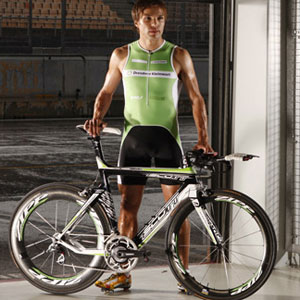
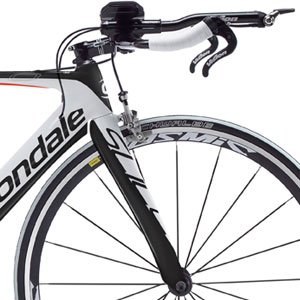
Start the discussion at slowtwitch.northend.network